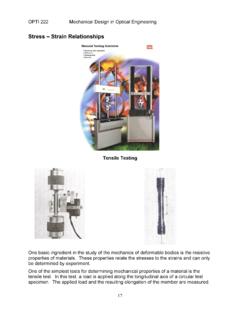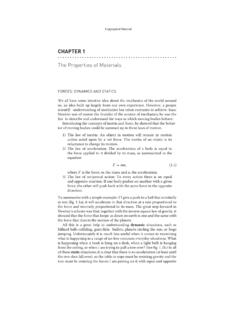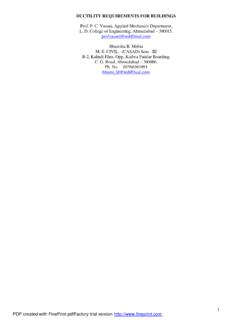Transcription of STRENGTH OF MATERIALS
1 UNIVERSITY OF ANBAR COLLEGE OF ENGINEERING DAM & WATER RESOURCES STREMGTH OF MATERIALS STRENGTH OF MATERIALS Lecture Notes Prepared by: Assistant Professor Dr. Ayad A. Sulaibi Structural Engineering Dr. Ghassan S. Jameel concrete Design and Technology Dams &Water Resources Engineering Department Second Stage 2st Semester 2018 - 2019 UNIVERSITY OF ANBAR COLLEGE OF ENGINEERING DAM & WATER RESOURCES STREMGTH OF MATERIALS Course Description The course named " STRENGTH of MATERIALS " or " mechanics of MATERIALS " deals with, Concept of stress , Stresses and strains, Axial loading and axial deformation, Hook s law, Statically indeterminate members, Stresses due to temperature, Torsion, Internal forces in beams, pure bending or Beam theory, Transverse loading and shear stresses in beams, beam deflection, Transformation of stresses and strains.
2 Principal stresses and strains, in addition to Axially compressed members and buckling of columns. UNIVERSITY OF ANBAR COLLEGE OF ENGINEERING DAM & WATER RESOURCES STREMGTH OF MATERIALS Course Objectives 1. Be aware of the mathematical background for the different topics of STRENGTH of MATERIALS introduced in this course. 2. Understanding of stress concept and types of stresses. 3. Understanding of stress strain relationship and solving problems. 4. Understanding of internal forces in beams, how to draw shear force and bending moment diagrams. 5. Understanding of beam analysis, stresses in beams, beam theory and shear stresses. 6. Understanding of torsion in shafts, determination of shear stresses and twisting angle due to torsion.
3 7. Understanding of methods of calculation beam deflection. 8. Understanding of transformation of stresses and constructing of Mohr s Circle. 9. Understanding of Axially compressed members and buckling of columns. UNIVERSITY OF ANBAR COLLEGE OF ENGINEERING DAM & WATER RESOURCES STREMGTH OF MATERIALS REFERENCES 1. STRENGTH of MATERIALS (Fourth Edition) Ferdinand L. Singer , Andrew Pytel . 2. mechanics of MATERIALS (sixth Edition) Ferdinand P. Beer, E. Russell Johnston, Jr. 3. mechanics of MATERIALS (Seventh Edition) Hibbeler. 4. Intermediate mechanics of MATERIALS (2001) BARBER. 5. mechanics of MATERIALS (2002) Madhukar Vable . 6. mechanics of MATERIALS (Seventh Edition) James M. Gere , Barry J.
4 Goodno. 7. mechanics of MATERIALS (2000) Anthony Bedford, Kenneth M. Liechti . 8. Introduction to mechanics of MATERIALS (1989) William F. Riley, Loren W. Zachary. 9. mechanics of MATERIALS (Fourth Revised Edition) James M. Gere, Stephen P. Timoshenko. 10. mechanics of MATERIALS (Sixth Edition) William F. Riley, Leroy D. Sturges, Don H. Morris. 11. mechanics of MATERIALS (Second Revised Edition) Roy R. Craig, Jr. 12. mechanics of MATERIALS (1985) David Q. Fletcher. 13. mechanics of MATERIALS (Second Edition) E. P. Popov. UNIVERSITY OF ANBAR COLLEGE OF ENGINEERING DAM & WATER RESOURCES STREMGTH OF MATERIALS TOPICS 1. concept of stress 2. Concept of strain 3. Statically indeterminate problems 4. Thermal stresses 5.
5 Stresses in thin wall vessels, Poison's ratio 6. Beams, shear force and bending moment equations. 7. Shear force and bending moment Diagrams 8. Stresses in Beams, Bending stresses 9. Shear stresses in Beams 10. Deflection of Beams 11. Torsion 12. Buckling of Columns 13. stress Transformation and Mohr's Circle 14. Problems on Mohr's Circle UNIVERSITY OF ANBAR COLLEGE OF ENGINEERING DAM & WATER RESOURCES STREMGTH OF MATERIALS CHAPTER 1 stress Concept of stress : Let us introduce the concept of stress , as we know that the main problem of engineering mechanics of material is the investigation of the internal resistance of the body, the nature of forces set up within a body to balance the effect of the externally applied forces.
6 The externally applied forces are termed as loads. These externally applied forces may be due to any one or more of the followings: (i) due to service conditions (ii) due to environment in which the component works (iii) through contact with other members (iv) due to fluid pressures (v) due to gravity or inertia forces (Self weight of the structure). As we know that in mechanics of deformable solids, externally applied forces acts on a body and body suffers a deformation. From equilibrium point of view, this action should be opposed or reacted by internal forces which are set up within the particles of material due to cohesion. These internal forces give rise to a concept of stress .
7 Therefore, let us define a term stress : stress : Let us consider a rectangular bar of some cross sectional area and subjected to some load or force (in Newton ). Let us imagine that the same rectangular bar is assumed to be cut into two halves at section XX. Each portion of this rectangular bar is in equilibrium under the action of load P and the internal forces acting at the section XX has been shown. UNIVERSITY OF ANBAR COLLEGE OF ENGINEERING DAM & WATER RESOURCES STREMGTH OF MATERIALS Simple stress Simple stress is expressed as the ratio of the applied force divided by the resisting area or : = Force / Area. It is the expression of force per unit area to structural members that are subjected to external forces and/or induced forces.
8 Here we are using an assumption that the total force or total load carried by the bar is uniformly distributed over its cross_section. Units : The basic units of stress in units (International System) are N / m2 (or Pa , Pascal) MPa = 106 Pa , GPa = 109 Pa , KPa = 103 Pa Sometimes N/mm2 units are also used, because this is an equivalent to MPa , while US customary unit is pound per square inch , psi. (lb/in2). Simple stress can be classified as normal stress , shear stress , and bearing stress . Normal stress develops when a force is applied perpendicular to the cross-sectional area of the material. If the force is going to pull the material, the stress is said to be tensile stress and compressive stress develops when the material is being compressed by two opposing forces.
9 Shear stress is developed if the applied force is parallel to the resisting area. Example is the bolt that holds the tension rod in its anchor. Another condition of shearing is when we twist a bar along its longitudinal axis. This type of shearing is called torsion and covered in Chapter 3. Another type of simple stress is the bearing stress , it is the contact pressure between two bodies. ( It is in fact a compressive stress ). Suspension bridges are good example of structures that carry these stresses. The weight of the vehicle is carried by the bridge deck and passes the force to the stringers (vertical cables), which in turn, supported by the main suspension cables.
10 The suspension cables then transferred the force into bridge towers. UNIVERSITY OF ANBAR COLLEGE OF ENGINEERING DAM & WATER RESOURCES STREMGTH OF MATERIALS Normal stress The resisting area is perpendicular to the applied force, thus normal. There are two types of normal stresses; tensile stress and compressive stress . Tensile stress applied to bar tends the bar to elongate while compressive stress tend to shorten the bar. = Force / Area = P/ A Bar in Tension Bar in Compression where P is the applied normal load in Newton and A is the area in mm2. The maximum stress in tension or compression occurs over a section normal to the load.








